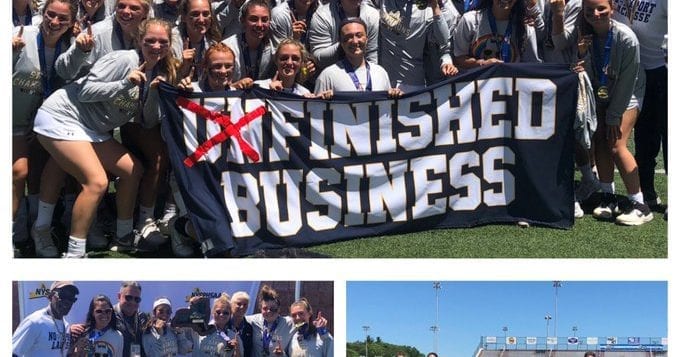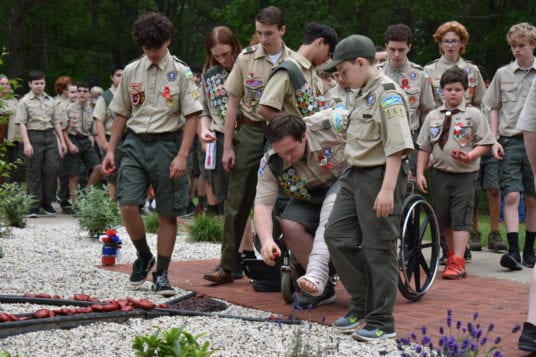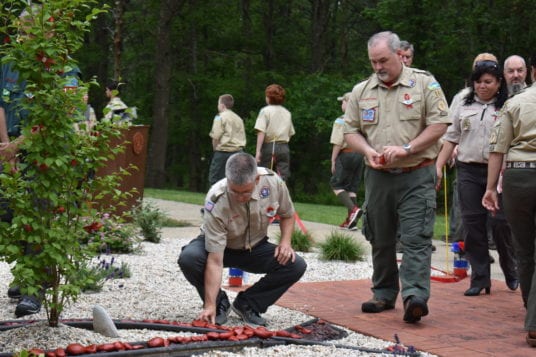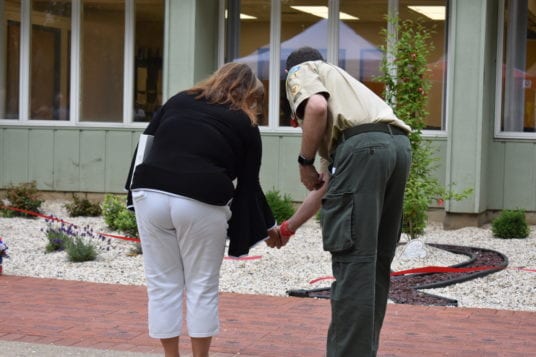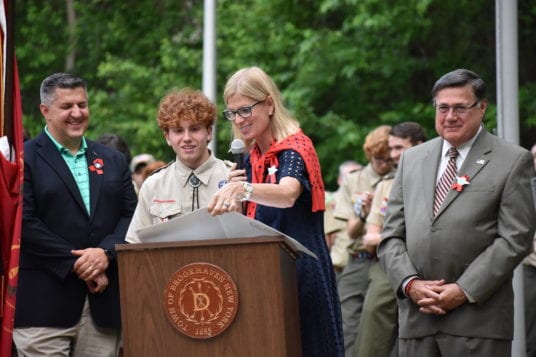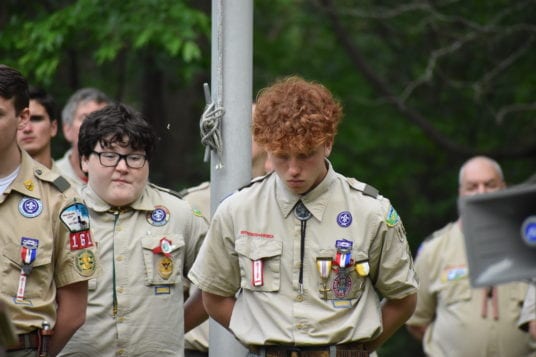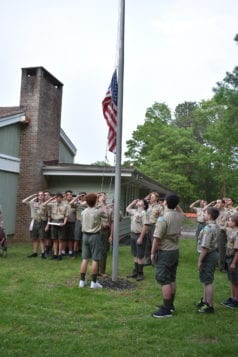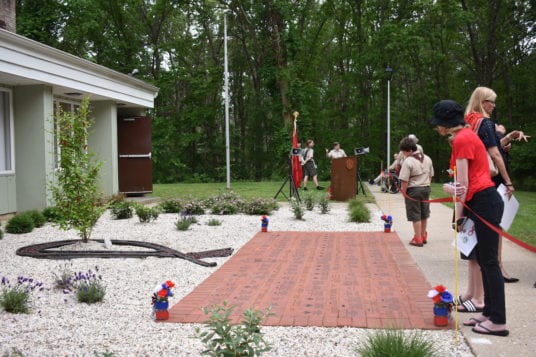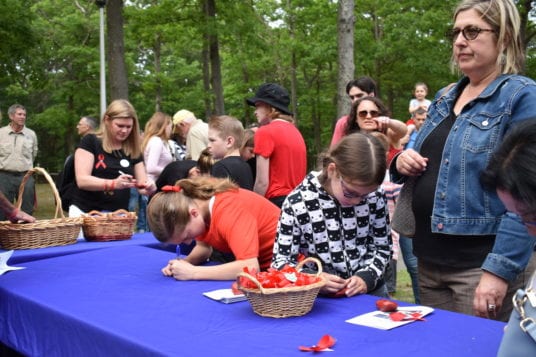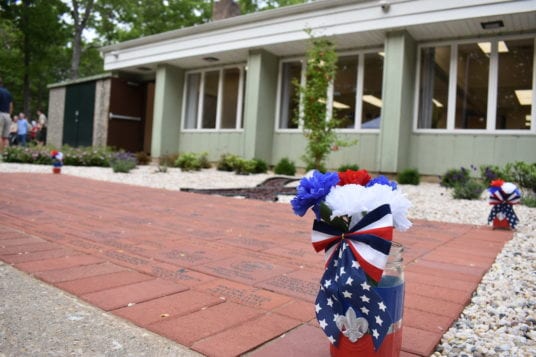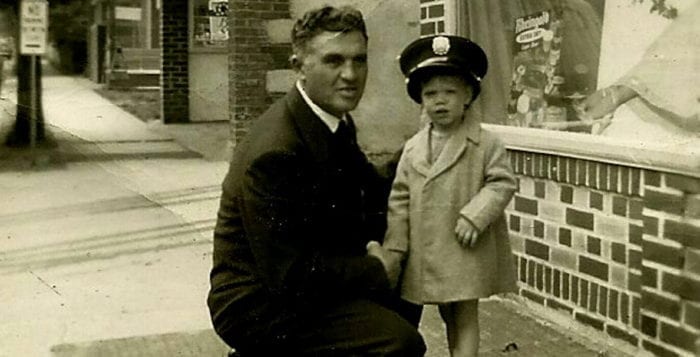Winning the Suffolk Championship wasn’t the goal for the Northport girls lacrosse team, though they went on to capture the Long Island title defeating Farmingdale on June 1, punching their ticket to the New York State semi’s at SUNY Cortland. Then, the Tigers mauled Pittsford 13-3 on Jun 7 to reach the Class A Championship game the following day against Baldwinsville. Unlike the contest the previous day, the Tigers had their hands full, but where able to hold their opponents at bay June 8 to win the game 10-8 to raise the championship plaque.
Yearly Archives: 2019
Boy Scout Troop 161 unveils new garden to fallen member
Troop, town and community all had a hand in the new memorial



The Boy Scouts of Troop 161 formed lines, and in each of their hands, they clutched a small red stone. Their faces were reflective and grieved, and when they walked, they did so silently, placing those rocks around the symbolic ribbon outside the troop’s meeting place at the Robert E. Reid, Sr. Recreation Center in Shoreham, all to honor one of their member who was killed last year.
Since the death of Andrew McMorris, a fellow in their troop who was killed by a drunk driver in the fall of last year, the community has rallied in support of the family after their loss. On that June 5 evening the red stones were inlaid with phrases written by the community. Some were stenciled with “fly high Andrew” while others read “fly high on an eagle.”
The final part of the Scout law says the young men should remain “reverent,” and as they paid homage to Andrew, the Scouts in his troop remained solemn throughout the entire ceremony.
Alisa McMorris, Andrew’s mother, was struck by how much the community and Boy Scout troop came out to support her family.
“A part of me died that day, and I didn’t think that I could stand again,” she said. “When the boys and the troop surrounded us, and the community surrounded us, we realized we had a support that would go to any lengths to help us take the next step forward.”
John McMorris, an assistant Scoutmaster in Troop 161 and father of Andrew, could barely hold back tears as he spoke to the crowd of gathered town officials and friends of the troop.
“It’s a beautiful place to do it where we hold our meetings every week,” he said. “Andrew loved Scouting, he loved his Scouting brothers.”
The new garden in honor of Andrew is located just outside the windows of the Shoreham community center, facing toward the playground. Members of the troop have been working on the project for months. In May, the troop spent hours upon hours on one of the hottest days in spring to help dig the ground for the project.
Since October the troop had spent months planning and then building the garden, starting with the red dogwood tree, which was donated by local Girl Scout Service Unit 69. Alisa McMorris is a Girl Scout troop leader, and her daughter, Arianna, is a member.
“We thought, what a beautiful way to merge the two Scout worlds is to put a garden around that tree,” she said.
In all, it has been a complete Scout effort. Joseph Pozgay, 16, who was named an Eagle Scout earlier this month, made it his Eagle Scout project to lay the bricks in front of the new garden. The idea came to him from a friend, Ryan Ledda, who used his Eagle Scout project to construct a memorial statue for Thomas Cutinella, who died in 2014. He said he remembered Andrew, the whole troop did, as a young man with great ambitions.
“I feel honored — I feel like I’ve achieved something,” Pozgay said.
Ken Wrigley, an assistant Scoutmaster and owner of Wading River-based Emerald Landscaping, helped to design the new garden. He said some of his distributors donated the plantings seen placed around the rock ribbon and red dogwood tree.
So much had been donated to the project that there were thousands of dollars left over. In the next Brookhaven town board meeting, officials voted to take a donation of $6,839 from the troop and use the funds to construct a pergola at the town-owned community center, near the troop-built garden.
“It’s commendable for Brookhaven that the Scouts have taken the center under their wing,” said Councilwoman Jane Bonner (R-Rocky Point). “The fact that so much money was left over shows just how generous people have been with donations.”
Throughout the ceremony, Alisa McMorris kept raising her eyes to the sky. Above, the clouds had rolled in an overcast, threatening rain throughout the evening, but Alisa was watching and listening for something. That’s when they heard it, a plane overhead, likely a passenger jet.
To the McMorris family, it was a sign. Andrew had wanted to be a pilot, and the Shoreham-Wading River middle school student had flown in local youth pilot programs.
“It’s helping healing occur — it’s helping us move forward,” Alisa said.
Immigrant groups advocate for Green Light NY

Immigrant rights groups, religious leaders, labor union groups and residents rallied in Hauppauge June 7 to advocate for a bill that would allow undocumented immigrants to obtain driver’s licenses.

Proponents of the bill argue that it would improve public safety and the economy. The bill would require undocumented immigrants to take a driver’s license exam and be able to buy car insurance.
“We are disappointed that the six Democratic senators have not come out in favor of Green Light yet,” said Patrick Young, program director of the Hempstead-based Central American Refugee Center.
Jay Jacobs, the Nassau County Democratic chairman, recently said he called the six senators who represent Long Island to warn them about the potential political backlash of supporting the bill, according to an article in Gothamist.
“Jay Jacobs advised them not to support the bill,” Young said. “There may be opposition to the bill, but the people who voted for [the senators] did oppose Green Light.”
According to Young, many of the senators campaigned in support of the bill but now have changed their stance. One of those he said in particular was New York State Sen. Monica Martinez (D-Brentwood).
“She said she would support it, now she’s saying she’s not supporting it,” he said. “We need her to come back on board.”
After the rally, volunteers began calling the six Long Island state senators in hopes of getting them to reconsider their stance on the bill.
“We told them if you don’t vote for it for political reasons, we will start this campaign back up again in January,” he said. “This is not going away.”
Republicans in the state legislature have shared opposition to the Green Light NY bill, with many arguing that allowing undocumented immigrants to obtain driver’s licenses would leave county clerks and employees at local Departments of Motor Vehicles unable to truly verify authenticity.
“We must put the brakes on this unfair proposal which ignores the overwhelming opposition of our citizens to grant this privilege to illegal immigrants,” said New York State Sen. John Flanagan (R-East Northport) in a release. “We must red light the Green Light bill that simply opens up our system to fraud and places a burden on county clerks and DMV employees to verify the authenticity of foreign documents as proof of identification,”
New York State Sen. Ken LaValle had similar sentiments.

“I was a member of a New York State Senate Task Force on Immigration and I have studied this issue at great length,” he said in a release. “I remain steadfast in my position that granting driver’s licenses to undocumented immigrants is not good public policy, presents a clear threat to public safety and sends a wrong message to the law-abiding people I represent,”
Ivan Larios, of the New York Immigration Coalition, said there are misconceptions with this bill, one being that it will somehow allow undocumented immigrants to gain citizenship.
“The bill will allow them to purchase a vehicle and get insurance,” he said. “And do everything by the books.”
Larios said in some cases many individuals decide to drive without a license and take the risk of being pulled over, though if they were to get into an accident it would leave them in a tough situation.
“This is very important for families because it allows them to take their kids to school, go to work, do everyday stuff, said Larios. “And they would have to go through the same process [of getting a license] just like you and me have to go through.”
The bill has passed through the state assembly but is facing some opposition by Democrats, even in a Democrat-controlled state senate. The measure is expected to be voted on in the upcoming weeks.
Young said every other Democratic in the state is supporting the bill and they have 25 co-sponsors as well as another six senators that would vote for the bill
“Though none of them are from Long Island and that is horrific,” he said.
Huntington town leads organ donor crusade

It’s as simple as signing a box on the back of your state driver’s license. Yet, New York ranks dead last in the country for the percentage of residents registered as organ donors, according to LiveOnNY, a nonprofit organization helping New Yorkers live on through organ and tissue donation.
The people in Huntington Councilman Mark Cuthbertson’s (D) office know firsthand how critical it is to participate in the program. Both Cuthbertson and his legislative aide Michele Martines have children that needed transplants. Their ordeal has motivated them to spread the word about the importance of signing the organ donation registry.
“You can save a life,” said Martines.
In 2015, her 21-year-old son Christian received a heart transplant. He was diagnosed at age 18 with dilated cardiomyopathy and suffered cardiac arrest about a year later. Luckily for Christian and his mother, they ultimately received a call that they found a donor. Martines said many are not that lucky and die waiting for a donor.
“We didn’t know at the time that the left side of his heart had failed and if he didn’t get the call for his heart he would have passed away that night.”
Every 18 hours a New Yorker dies waiting for a donor, she said. “In New York it can take up to seven years to receive a kidney or liver transplant.”
Cuthbertson also has been affected personally by organ transplants. His son, Hunter was diagnosed in 2016 with aplastic anemia during a precollege physical. The condition causes a failure of the bone marrow to produce the necessary amount of red blood cells. The chance of finding a perfect match in bone marrow with a relative is only 20 percent, but he found that his brother was a perfect match. In 2017, Hunter received a bone marrow transplant.
“I was elated when I learned he was a match, I dropped to my knees and I was crying,” Hunter said in a May 2018 Times of Huntington article.
Despite efforts in recent years to improve the rate of organ donations, New York still lags behind the rest of the country. Only 32 percent of New York State residents are signed up as organ donors. The nationwide average is 56 percent.
Since his surgery, Christian has taken up public speaking to local schools and advocating the need for organ donors.
“We need to educate more people about organ transplants,” Martines said. “Christian goes out and talks to kids and tells them his story.”
And the Town of Huntington has moved to the forefront of advocating the need for more donors on the registry. Beginning in 2018, the town began hosting a 5k Run to Save Lives, which highlights the statewide problem. Participants at this year’s event helped raise $11,000. All proceeds went to three nonprofits that handle and advocate organ and tissue donations: LiveOnNY, Be the Match and Team Liberty.
Dr. Alan Gass, medical director of heart transplant and mechanical circulatory support at Westchester Medical Center oversaw Christian’s transplant surgery. He said there needs to be more education about organ donations. He wants people to know that transplants work and it’s not just the rich and famous who receive organs.
“Most patients live on for decades after getting a transplant,” he said. “Being a donor is the ultimate way of giving back.”
Martines said she hopes the work she and others are doing will eliminate misconceptions and help increase the number of people who sign up to be donors. “We’ll continue to try and make a difference here,” she said. “My son is alive because of a total stranger.”
Meet the five young Port Jefferson residents helping people park
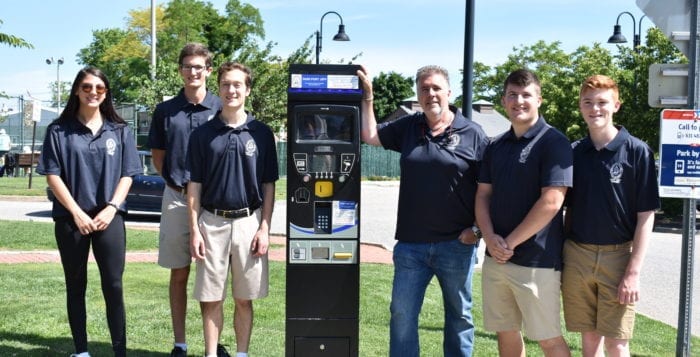
Four young men and one young woman can be seen by the meters in Port Jefferson with polo shirts emblazoned with Port Jefferson parking. Their job is to answer the question that’s on the lips of so many visitors and residents alike; “where do I park?”

The first parking ambassador was introduced to the village last year, according to Kevin Wood, the village parking and mobility administrator.
“They bring that human touch to the operation of paying for a space,” Wood said. “Beyond that, they’re all Port Jefferson residents, so they know where everything is.”
All but one of the parking ambassadors are seniors at the Port Jefferson High School. Connor Kaminska, one of the village’s first parking ambassador, finished his first year at the Massachusetts Institute of Technology and is back for the summer. Beyond fielding questions from confused visitors, Kaminska also uses his technical skills to fix the meter stalls he comes across
“I usually start off a shift with checking if they’re working,” he said. “If not then I usually fix them, take out the motherboards and catch boxes, just get them working… It’s nice being outside, helping people.”
The other four parking ambassadors include Port Jefferson High School seniors David Rotunno, Gavin Barrett, Reid Biondo and Amanda Brosnan. The young people work four to five days a week on four- to six-hour shifts, depending on how busy the village is at the time. They are paid $12 an hour, of which the money comes from the managed meter fund. During events like the Mini Maker Faire June 8, most of the ambassadors were out fielding questions about the meters.
Wood said, on a typical night, two ambassadors will be out for around four hours from 4 to 8 p.m. One is usually located on the west side of Main Street while the other focuses on the eastern end.
The parking administrator said the idea came from fielding many questions from visitors and residents while working on village meters.
“I found that 90 percent of questions are: how do I do this, what are the hours, does the machine give change, where is this restaurant, what time does this close, what time can I park here until,” he said. “The word ambassador is correct, Port Jeff ambassador.”
Brosnan saw an ad for the job on Facebook, and said she thought to herself, “Oh, I can walk around the village, help people and get paid for it.”
She added it’s especially helpful for when the village gets busy, and there’s hardly any spot to find within the entirety of Port Jeff. She usually suggests people find spots near the CVS or the Village Center in the back lot.
“Port Jeff is a tourist town, and people don’t know how to use it, even if there’s signs on the meters,” she said. “Sometimes the machine glitches, or just somebody isn’t sure what to do, so we’re there to help them with it.”
Biondo, a fellow high school senior, is also doing his first season as a parking ambassador. He finds he’s often acting as a facilitator for the parking meters, helping people understand how they can pay for their spot, where some machines don’t accept cash, and none give change. He also tries to tell people about the mobile app MobileNOW!.
“People do enjoy it, because it’s just one less hurdle for them to come and enjoy the village,” Biondo said.
“There’s no secret that there’s parking anxiety in Port Jeff.”
— Kevin Wood
Each of them has a consistent question they hear most often. Kaminska said he often hears about how one can add time to a spot and where certain restaurants are to give them “a lay of the land.”
Brosnan often gets asked where meters are, if meters apply directly to spots, or if they can be used for every spot in the village. Answer: the meters can interact with every parking spot.
Though it’s not necessarily an easy job. The ambassadors are always on their feet. With smart watches and Fitbits. Biondo said he has tracked more than 30,000 steps in a day, while the lone girl on the ambassador team said she had once tracked over six miles of walking distance in a shift.
All but Kaminska will be graduating by the end of June. Brosnan will be going to Salve Regina University in Rhode Island, Rotunno will be going to Carnegie Mellon University in Pittsburgh, Barrett will be going to Binghamton University in Upstate New York, and Biondo will be attending the University of Virginia.
Wood said their work has been invaluable so far this season.
“There’s no secret that there’s parking anxiety in Port Jeff,” Wood said. “These wonderful human beings just by being present calm that anxiety.”
More about parking can be found at https://portjeff.com/parking/
Hairport celebrates 45 years of business in PJ
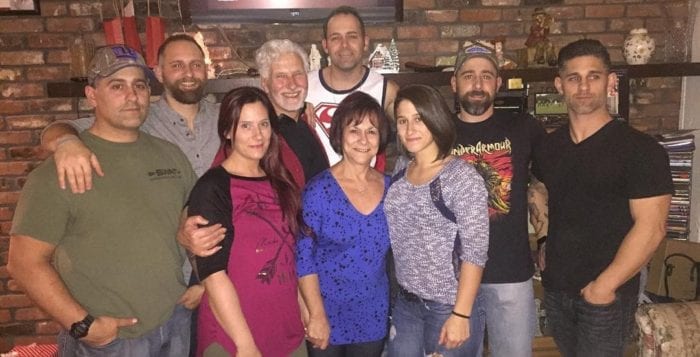
For Raymond LaGala, owner of Hairport in the Village of Port Jefferson, cutting people’s hair is a feel-good business. Great service and treating his clients right — that is what he said has been bringing people back for the last 45 years.
“You have to love what you do,” he said. “I’m glad that I still enjoy it.”

LaGala said he had the idea of one day opening his own shop since he first became a hairdresser. He learned the craft working at shops in Merrick and Great Neck, and in 1973, he decided to try opening his own business.
The longtime stylist and barber had visited Port Jeff before and thought it would be a good place for his salon. In June 1974, Hairport was born and has resided in the same spot on Main Street since.
The Port Jeff business owner said his shop was one of the first unisex salons in the area at the time.
“As we got busier, we kept expanding,” LaGala said.
They then expanded into barbering and along the way his children became involved in the family business.
One of his sons, Thomas LaGala, began barbering at the salon when he was 17 years old, and was followed by his brother Jason, who said he wanted to learn hairdressing so his father sent him to a school in the city.
From there, the two sons and a nephew of Raymond, James, began barbering in the back of the salon and it proved to be successful.
Jason said he remembers coming into the salon when he was a kid and he would watch his father cut clients’ hair. The young man thought it seemed like a fun place to work.
“For me it was a cool time growing up, working for my dad,” Jason said. “He taught me to always take care of the customer.”
Throughout the years, two other children, David and Joann, joined the business. James and Jason, after working at Hairport for some time, decided to open their own business across the street after some encouragement from their father. The pair now run the Men’s Room Barbershop on Main Street in Port Jeff, with James as owner and Jason as partner.
“Running a business is not always easy. It is an uphill battle,” Raymond said. “You have to be able to adjust — it is forever changing.”
The father of seven stressed the importance of not assuming customers will come back just because you are around.
“You can’t take them for granted. If you treat them right they will be back,” he said.
Over the years, the salon has built up a loyal client base who appreciate the service and honesty. Raymond mentioned it is all about the relationships you cultivate with your customers.
Jason said he is proud that the family-run business is still striving.
“It is cool to have a successful business grow with the area it’s been in,” he said. “It has become a staple of the village.”
Jason said it has been nice watching a family man, in his father, take care of his family.
Raymond said the key to success is that you can’t rest on what you did in the past; you have to keep going forward
“We are still here, making noise,” he said.
This post has been amended June 19 to better reflect the ownership of Men’s Room Barbershop.
A son’s thank you to his dad on Father’s Day
By Jim Soviero
My father, Salvatore (Sam) Soviero, was a loving, devoted husband, father and son. A robust, upbeat man, born in 1914 to Italian immigrants Vincenzo and Louise Soviero, Dad’s life by today’s standards was a tough one. Beginning at a very young age, he caddied, worked construction, ground the grapes for wine and wound up boxing to “put money on the table.”
Given his extraordinary success as an adult, Dad rightly figured it would be smart to raise his son in pretty much the same way he was raised. Dramatic global changes notwithstanding, Salvatore would follow two basic principles: he’d set a good example and enforce firm limits.
Sam lived an exemplary life. He was a man of great integrity who worked tirelessly to support his family.
One of his most poignant lessons on “doing the right thing” came while he and I were going through some of his old fight posters. Sammy was a very good light heavyweight who had trained at Stillman’s Gym with top fighters of the day. Pointing to one opponent, Dad said, “That guy cost me a shot at a big fight.” When I mentioned not recalling him losing to “that guy,” my father looked down, before quietly saying, “I didn’t.”
At his beloved bride Dorothy’s insistence, and during the height of the Depression, Sal became a welder. After my older sister was born, he’d make extra money by working nights and clamming during the day. When we grew out of our tiny two-bedroom bungalow in Huntington Station, he and his brother Joe began dismantling one of Grandpa’s old houses. Over the course of several years, that brick and timber was used to build our family a beautiful, spacious Cape Cod in Halesite.
Given that kind of legacy, when Dad interrupted what looked to be this 14-year-old’s summer fun at the beach with the news I’d begin caddying at the Crescent Club — and putting my earnings on the table — it seemed natural, even flattering.
But while trying to follow Dad’s best life lessons was important, following his rules proved to be equally important. One of the most difficult but critical decisions for parents is to judge when it’s necessary to cause their children short-term pain, in exchange for what Mom and Dad hope will be long-term benefits. My father had uncanny commonsense instincts that led him to set perfectly timed restraints on yours truly.
I, like virtually every 16-year-old boy, couldn’t wait to get my driver’s license. Dad, like most parents of a 16-year-old, knew the inherent risks. He responded proactively. My first moving violation meant Salvatore took my license for six months. An accident that was my fault cost me the car for a year.
Some disciplined teenage driving meant I’d lose neither the car nor my life. Around the same time, over roughly a two-year period, four classmates died in horrific auto accidents, devastating the lives of their families and friends.
Whether leading by example or setting firm limits, having Salvatore Soviero for my father was one of the greatest blessings any son could ever have asked for.
Thanks for everything, Dad.
Jim Soviero resides in East Setauket and is a former teacher in the Half Hollow Hills Central School District who renovated and built houses part-time just like his father.
Miller Place wrestler takes it to the mat at Vin Altebrando Wrestling Festival

By John Schreck
On June 8, many wrestlers from high schools and middle schools across Long Island took part in the second annual Vin Altebrando Wrestling Festival in Huntington, hosted in honor of the beloved Walt Whitman High School coach who died last year.
The above photo depicts Miller Place residents Brian Schreck and his proud brother Eric Schreck. Brian competed in the tournament.
Brian won the “hammer” trophy — first place for his weight class of 127-132 pounds for middle schools.
John Schreck is a Miller Place resident.
Community Corner submissions are accepted for every issue. If you have a story you would like to submit, even something as small as a story of finding a lost dog or a small accomplishment of your own, send it to [email protected]
Family pub celebrates 50 years
Old Street Pub, Smithtown’s iconic restaurant and bar, opened its doors 50 years ago, and it’s been serving generations of loyal Smithtown customers ever since. So, what’s been the secret to their success?
“We do have the best burgers around,” said Laura Lombardi, who owns the restaurant with her parents Nancy and Frank Pizzimenti, and her brother Frank Jr. “We use only fresh ingredients — nothing frozen — and our brioche buns, which we get from Alpine Bakery, are baked daily,” Pizzimenti Jr. added.
Old Street is also famous for their cheese and crackers “Old Street” way, marinated steak sandwich, French onion soup and Caesar salad. With a large menu of burgers, steaks, chicken, appetizers, soups, salads, sandwiches, wraps, seafood and pasta, the restaurant offers something for everybody.
The recipe for success, though, for this family-run business also includes individual service.
“We are told on a daily basis by our customers that we make everyone feel comfortable,” said Lombardi. “A lot of our customers call Old Street ‘home’ — we couldn’t ask for a better compliment.”
That homey atmosphere has been a tradition that has inspired not only loyal customers, but also the employees. Joseph LaRock, chef, bartender and manager, has been a mainstay at the restaurant for 32 years. Joanne Gregory, a bartender, has been there for 13 years.
As for Pizzimenti Jr., he started working at the restaurant as a dishwasher in 1986, at age 17. He climbed the ranks and learned the business. Ten years later, he got his family involved when the restaurant’s longtime owners, the Atamanchuk family, decided to sell the restaurant.
When the Old Street Pub first opened in 1968, a few things were different. Namely, the restaurant was originally called Gold Street Pub. When the “G” fell off their sign about a year later, the Atamanchuk family decided to go with it.
“Fifty years ago, Old Street was busy day and night, seven days a week as there were only two other restaurants in town,” Pizzimenti said. “Now we have to work even harder to get people into our establishment as there are so many other restaurants to choose from in the area.”
The restaurant once had extremely busy corporate lunches, which included porterhouse steaks, martinis and desserts. With the recession in the early 2000s, their lunch crowd shrank drastically.
“That was probably the biggest obstacle we had to overcome,” Lombardi said. “Other than working with family.”
Approximately 10 years ago, the restaurant started offering weekly specials.
“We like to include seasonal menu items and use local products in our specials,” she said.
The restaurant is located in the busy Branch Plaza shopping center at the intersection of Main Street and Route 111. The restaurant’s brick facade, arched windows and heavy, carved wooden door flanked with colorful planters announce that it’s not your run-of-the-mill, strip mall eating establishment. Once you walk through the main entrance, you can enter either the dining room to the left or the pub to the right. The same fresh food can be ordered on either side, only the atmosphere differs slightly. The dining room seats 75 people and is decorated with white tablecloths. It appeals to families, but is also known to be a good choice for people on dates or catered affairs.
The wood-paneled pub includes barstool seating and a large area with upholstered booths.
Old Street serves thousands of people monthly. Some patrons admit that the restaurant’s attraction is simply its close proximity to their homes. But the family’s commitment to their loyal customers is undeniable.
“You have to be extremely passionate and hardworking,” Lombardi said. “You make a lot of sacrifices working nights and weekends. You are constantly away from your family, and dealing with daily deadlines, and you never know on a daily basis how many people will be walking through the door, but you always have to be ready.”
The restaurant business is clearly a tough business, but things have fallen into place for Old Street, either through intentional planning or in case of the name by mere happenstance.
“We’re not perfect,” said Pizzimenti Jr. “But we try.”
The D-Day decision
How Eisenhower made the choice that would lead to the end of the Third Reich
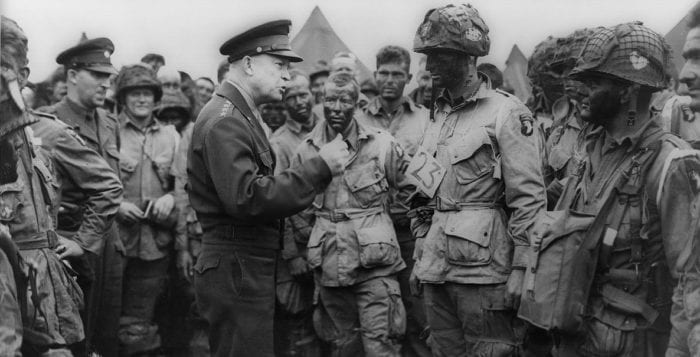
By Rich Acritelli
In the early morning hours that led up to the D-Day landings, former general and later president Dwight D. Eisenhower had to make one of the most vital military decisions to determine the fate of plans to invade Normandy, France. While tens of thousands of men were waiting on ships that were being loaded with everything from blood to tanks, Eisenhower was delayed by hazardous weather. It was determined that the water conditions were too rough to launch and land the soldiers who were expected to make it ashore with tons of gear and against the fire of the German army. Senior officers Gen. Omar N. Bradley and Field Marshal Bernard Law Montgomery, and chief of staff Gen. Walter Bedell “Beetle” Smith, watched as Eisenhower was completely alone in determining if the Allies should carry out this attack.
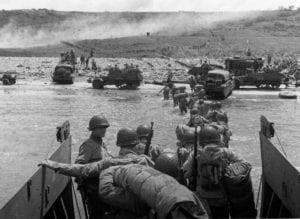
As Eisenhower walked around the room, he was briefed by his meteorologist about a brief break in the weather that would possibly allow the Allied landings to reach the beaches of Normandy. The general heard Montgomery’s beliefs that all should be risked at this point. He also learned that if they did not go at this moment, it was likely that the Allies would have to wait until July to attack the shores of France due to poor weather reports. While these forces waited in large numbers, Eisenhower fully understood that Hitler was bound to learn of his plans to attack Normandy. He refused to allow noted Field Marshal Erwin Rommel the time to strengthen the French coastline with additional armaments, fortifications and resources to halt this Allied assault. Even as Eisenhower watched the success of Operation Fortitude’s ability to deceive Hitler of the Allies’ false accounts to attack the French location of Calais in the south and Norway in the north, this was too much of a secret to hold on to much longer.
In Germany, Hitler refused to listen to his generals in allowing flexibility within the deployment of Panzer tanks situated in Calais. Eisenhower tricked Hitler into believing that he would attack Calais, which was the closest French landing spot on the English Channel, but as he prepared for D-Day, the American general continually worried about this information being leaked out to the enemy. These fears were presented through a West Point classmate of Ike. Maj. Gen. Henry J.F. Miller was the commander of the 9th Army Air Force Service Command. He made a serious blunder that could have been extremely costly. Drunk, he was overheard speaking about these sensitive invasion plans in a busy English restaurant. It was described by a younger officer that Miller spoke in an arrogant manner and that he showed no discipline in loudly addressing top secret plans to civilians. Right away Eisenhower questioned him and quickly sent his good friend home to the United States, where he was demoted to his previous rank of colonel.
As he was surrounded by the likes of Prime Minister Winston Churchill, the deposed President of the French Republic Charles de Gaulle and Montgomery, his thoughts were never far away from the rank and file who were tasked to carry out his directives. Although Eisenhower was confident of success against the German army, he feared that his men were bound to suffer heavy casualties against the enemy that was waiting for them at Normandy. At this time, Eisenhower’s son graduated from West Point as a second lieutenant on June 6, 1944, during the very moment that the Allies carried out this risky operation. He was always troubled that he was ordering soldiers younger than his own boy to their possible deaths. To soothe the stress that he felt from his heavy burden of command, Eisenhower smoked almost five packs of cigarettes a day.
There is a famous picture of Eisenhower meeting members of the famed 101st Airborne Division, taken in the hours before he approved the invasion. He was alarmed over the estimated reports that the paratroopers would endure heavy losses. Most of these fears were put to rest when Eisenhower personally asked the airborne where they were from in America, the college teams they followed and their lives before the army. This commanding general always searched for soldiers who were from his own hometown of Abilene, Kansas. Whereas Eisenhower was immensely powerful, he was a well-rounded officer, who enjoyed playing cards and sports, and was extremely well-liked. These junior service members calmly told Eisenhower not to worry about the air drops, as they were determined to defeat the Germans.
Miller’s behavior was contrary to the views of Eisenhower, who preached that every member of the armed forces from private to general was needed to operate as a team to win this war in Europe. The moments leading up to D-Day were perhaps the most difficult that he had to handle through his extensive time in the military and his two-term presidency. Whereas Miller flaunted his rank, he failed to understand that World War II impacted every type of American. Higher command figures like Gen. George C. Marshall lost his stepson during the fighting. Former President Theodore Roosevelt’s younger son Ted was a brigadier general who landed at Normandy and died five weeks after this assault of a massive heart attack. Even FDR’s four sons were all in uniform, where they saw combat duty in Europe and the Pacific.
As he pondered this vital decision, Eisenhower was constantly reminded of the poor conditions as the rain was heard hitting his headquarters in England. With his arms folded behind him, Eisenhower looked at the American and British officers and stated, “The question is, just how long can you hang this operation on the end of a limb and let it hang there?” With the risk of the weather, Eisenhower continued, “I am quite positive we must give the order. I don’t like it, but there it is … I don’t see how we can do anything else.” This directive by Eisenhower cut the tension in the room, as his key air, naval and army officers carried out their D-Day responsibilities. Eisenhower wrote a detailed letter accepting the failure of this operation if his forces were pushed back into the English Channel.
Eisenhower was a spectator observing the military might of this machine that he molded to destroy the might of the German military that waited behind the “Atlantic Wall.” This decision encompassed almost a year of intense training by the United States military and continuous day and nighttime bombing missions that targeted resources, bases, railroad lines and key targets that were able to support the enemy at Normandy. By June of 1944, Eisenhower was a seasoned leader who had learned from his own failures in North Africa and during the hard campaign to take Italy. He was extremely determined to defeat Hitler and drive the final nail in the German war machine to destroy their forces in France and move into Germany to gain a final victory. It was at this moment some 75 years ago that Eisenhower made the successful decision that led to the end of the Third Reich’s reign of terror in Europe.
Rich Acritelli is a social studies teacher at Rocky Point High School and an adjunct professor of American history at Suffolk County Community College.


